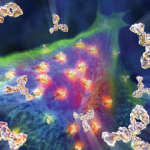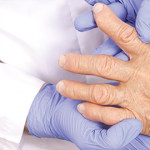“Our discovery was serendipity,” says Antony Rosen, MD, chief of rheumatology at Johns Hopkins University in Baltimore, of the studies that led to the unexpected discovery of antipeptidylarginine deiminase-4 (anti-PAD-4) antibodies as highly specific and potential markers of disease severity in rheumatoid arthritis (RA).
Published last year in Arthritis & Rheumatism (A&R), the groundbreaking study “was novel and extremely interesting,” according to David Karp, MD, PhD, chief of the rheumatic diseases division at the University of Texas Southwestern Medical Center in Dallas, who was not involved in the study.1 “When this is confirmed with more patients, it gives us promise of a biomarker, a possible diagnostic test, and the potential for RA prognosis.”
Prior to four years ago, the Hopkins research team had been working on features that unify autoantigens in the rheumatic diseases, but not specifically on RA. They knew that the noncoded amino acid citrulline is a frequent and specific target of autoantibodies in RA and that this amino acid is formed by the post-translational deimination of arginine in a reaction catalyzed by PADs. “One of the features we found that unified antigens is that they are cleaved by this molecule called granzyme B [GrB],” Dr. Rosen says. “When we found that GrB was actually cleaving PAD-4, the enzyme we were using to generate the citrulline, we knew it was an autoantigen. That was our ‘ah-ha’ moment that led to the published study.”
Funded by the Within Our Reach: Finding a Cure for Rheumatoid Arthritis campaign of the ACR Research and Education Foundation, the innovative work by Dr. Rosen and colleagues found that, although occurring less frequently than anticyclic citrullinated peptides (CCPs), anti- PAD-4 antibodies appear to be more specific than anti- CCP antibodies. Their analysis was conducted in blood samples from patients with established RA, patients with other rheumatic disease, and healthy adults. PAD-4 autoantibodies were found in 42% of RA patients and were very infrequent in controls.
When we found that GrB was actually cleaving PAD-4, the enzyme we were using to generate the citrulline, we knew it was an autoantigen. That was our ‘ah-ha’ moment that led to the published study.
—Antony Rosen, MD
The researchers determined that the anti-PAD-4 antibodies identified a subgroup of anti-CCP-positive patients that is enriched for the PAD14 susceptibility haplotype and more severe disease. Noting that a preliminary analysis shows that anti-PAD-4 antibodies occur less frequently in early disease (12%) compared with established disease, the team believed that anti-CCP antibodies precede the anti-PAD-4 immune response and that autoantibodies or T cells may participate in amplification pathways in RA. In their A&R study, the team suggested that “during conversion from the CCP-positive, asymptomatic phase of RA to the amplifying propagation phase of the disease, novel processing of the polymorphic form of PAD-4 allows generation of unique epitopes not previously tolerized, making initiation of an anti-PAD-4 immune response more likely.”
As to their hypothesis that the CCP antibodies precede PAD-4 antibodies, the team has now found the answer, but is waiting until the publication of their data before announcing these findings. In additional work since the A&R publication, Dr. Rosen and colleagues have looked at how the PAD-4 molecule is processed and presented to the immune system, and how it is modified in this process. Those findings are also expected to be published soon.
In additional studies, the researchers have sought to understand whether there are T lymphocytes specific for PAD-4, “which are important in finding patients with RA and may be an important driver for antibody response,” Dr. Rosen says. “We have demonstrated that those T cells are in fact present. Currently, we are trying to understand what activates them and how the two processes—the antibody and the T cell—are related.”
The team also hopes to learn if the PAD-4 antibodies appear as early markers before or after disease symptoms are noted. “We’ve had a collaboration with V. Michael Holers, MD, and his group,” Dr. Rosen noted. “From that analysis, it looks like those antibodies may be elaborated early in RA, and in some cases even before the disease symptoms begin. That’s interesting to us.”
In A&R, the Rosen team says their “data confirm that anti-CCP antibodies are found in the majority of patients with RA and are strongly associated with the presence of the shared epitope, but not with the PAD14 susceptibility allele. In contrast, anti-PAD-4 antibodies identify a subgroup of anti-CCP-positive patients that is enriched for the PAD14 susceptibility haplotype and more severe disease.”
Dr. Rosen noted that published studies by others provide support for his team’s work regarding anti-PAD-4 as a highly specific biomarker for the most severe, erosive form of RA.2-5 “There have also been studies showing that levels vary over time, which I think would be an interesting feature of these antibodies,” he says, adding that he and others are analyzing blood work from two large cohorts whose members with RA are being tracked over a long period of time.
Sue Pondrom is a medical journalist based in San Diego.
References
- Harris ML, Darrah E, Lam GK, et al. Association of autoimmunity to peptidyl arginine deiminase type 4 with genotype and disease severity in rheumatoid arthritis. Arthritis Rheum. 2008;58:1958-1967.
- Halvorsen EH, Pollmann S, Gilboe IM, et al. Serum IgG antibodies to peptidylarginine deiminase 4 in rheumatoid arthritis and associations with disease severity. Ann Rheum Dis. 2008; 67:414-417.
- Halvorsen EH, Haavardsholm EA, Pollmann S, et al. Serum IgG antibodies to peptidylarginine deiminase 4 predict radiographic progression in patients with rheumatoid arthritis treated with tumour necrosis factor-alpha blocking agents. Ann Rheum Dis. 2009; 68:249-252.
- Zhao J Zhao Y, He J, Jia R, Li Z. Prevalence and significance of anti-peptidylarginine deiminase 4 antibodies in rheumatoid arthritis. J Rheumatol. 2008;35:969-974.
- Auger I Balandraud N, Rak J, Lambert N, Martin M, Roudier J. New autoantigens in RA: Screening 8268 protein arrays with sera from patients with RA. Ann Rheum Dis. 2009;68:591-594.

